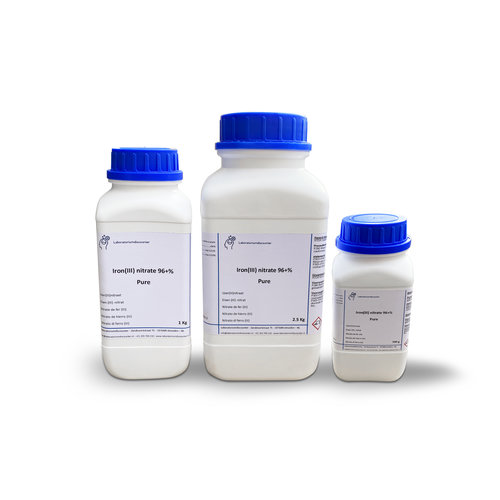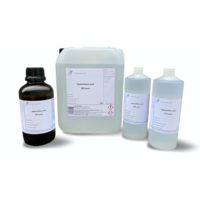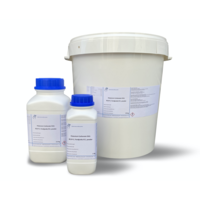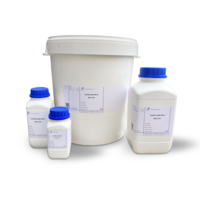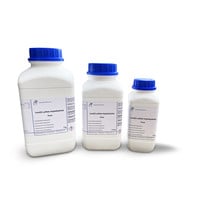You have no items in your shopping cart
Iron (III) nitrate 96 +%, pure
- Buy 2 and save 5%
- Buy 6 and save 10%
What is Iron(III) nitrate
Iron(III) nitrate or iron nitrate is the chemical compound with the condensed structural formula Fe(NO3)3. Because it is hygroscopic, it is usually found as a nonahydrate, Fe(NO3)3 · 9H2O, which usually consists of colorless to light purple crystals. This compound is prepared by treating metallic iron or iron oxides with nitric acid.
What is Iron(III) nitrate used for?
In the laboratory, iron(III) nitrate is the catalyst of choice for the synthesis of sodium amide from a solution of sodium in ammonia.
Some clays impregnated with iron nitrate have been shown to be excellent oxidants in organic synthesis. For example, iron nitrate introduced into a montmorillonite-A reagent called "Clayfen" has been used to oxidize alcohols to aldehydes and thiols to disulfites.
Iron(III) nitrate solutions are used by jewelers to engrave silver or silver alloys.
To produce iron(III) oxide (Fe2O3) as a color pigment, iron(III) nitrate is heated at just over 500 °C until it is completely decomposed.
Iron(III) nitrate is used as a catalyst and as a raw material for the production of catalysts.
Buy iron nitrate?
You will find iron(III) nitrate of the best quality at Laboratoriumdiscounter. Not only a fair price, but also available in different packaging with quantity discount! So order your iron(III) nitrate at Laboratoriumdicounter! Delivered quickly!
Welche Sicherheitsvorkehrungen sollte ich treffen, bevor ich Chemikalien verwende?
Es ist immer ratsam, beim Arbeiten mit Chemikalien so sicher wie möglich zu arbeiten. Auch Substanzen, die zunächst ungefährlich erscheinen, können enorme Schäden anrichten, wenn sie in die Augen gelangen. Tragen Sie daher immer eine Schutzbrille. Sie möchten auch verhindern, dass Chemikalien auf Ihre Haut gelangen, weshalb es wichtig ist, immer gute Handschuhe oder Einweghandschuhe zu verwenden.
Bei flüchtigen Stoffen, dampfförmigen Flüssigkeiten und staubenden Feststoffen ist Atemschutz erforderlich. Es gibt viele verschiedene Arten von Filtern, daher sollten Sie sich immer auf das Sicherheitsdatenblatt beziehen, um herauszufinden, welchen Filter Sie benötigen. Viele Filter geben auch an, für welche Substanzen sie bestimmt sind.
In einigen Fällen kann es notwendig sein, den ganzen Körper zu schützen, in diesem Fall ist ein Kunststoffoverall erforderlich, den Sie hier finden.
Bei der Arbeit mit brennbaren und oxidierenden Stoffen ist es wichtig, Feuerlöscher und Absorptionsmittel immer griffbereit zu haben. Es ist auch nützlich, verschüttete aggressive Chemikalien sofort mit Absorptionsmitteln aufzusaugen und sie gemäß den internationalen und/oder lokalen Gesetzen zu entsorgen.
Wenn Sie weitere Informationen zum Umgang mit einem bestimmten Stoff benötigen, konsultieren Sie immer das Sicherheitsdatenblatt. Sie finden diese auf der Produktseite oder fordern Sie sie über [email protected] an
What Safety Precautions Should I Take Before Using Chemicals?
It is always wise to work as safely as possible when working with chemicals. Even substances that do not seem dangerous at first can cause enormous damage if they get into your eyes. Therefore, always wear safety goggles. You also want to prevent chemicals from ending up on your skin, which is why it is important to always use good gloves or disposable gloves.
Respiratory protection is necessary for volatile substances, vaporous liquids and solids that dust. There are many different types of filters, so you should always refer to the MSDS to find out which filter you need. Many filters also specify which substances they are for.
In some cases it may be necessary to protect the whole body, in which case a plastic overall is needed, you can find it here.
When working with flammable and oxidizing substances, it is important to always have fire extinguishers and absorbents at hand. It is also useful to be able to clean up spills of aggressive chemicals immediately with absorbents and to dispose of them in accordance with international and/or local legislation.
If you need more information on how to handle a specific substance, always consult the safety data sheet. You can find this on the product page or request it via [email protected]
Technical data:
Empirical formula Fe(NO3)3 9 H2O
Molar mass (M) 404.0 g/mol
Density (D) 1.68
Boiling point (bp) 125 °C (Dec)
Melting point (mp)47 °C
Solubility soluble (H2O, 20 °C)
ADR 8 II • WGK 1
CAS No.[7782-61-8]
EC-No. 233-899-5 • UN No. 3260
$$$$$
Hazard statements
H314 Causes severe burns and eye damage
Precautions - prevention
P280 Wear protective gloves / protective clothing / eye protection / face protection.
Precautions - response
P303 + P361 + P353 IF ON SKIN (or hair): Immediately contaminate clothing
pull out. Rinse skin with water / shower.
P305 + P351 + P338 IF IN EYES: Rinse cautiously with water for a long period of time
amount of minutes; remove contact lenses, if possible; keep rinsing.

%%%%%
| MSDS Ijzer(III)nitraat (NL) |
| MSDS Eisen(III)nitrat (DE) |
| MSDS Irion(III)nitrate (EN) |
| MSDS Nitrate de fer(III) (FR) |
| MSDS Nitrato de hierro(III) (ES) |

